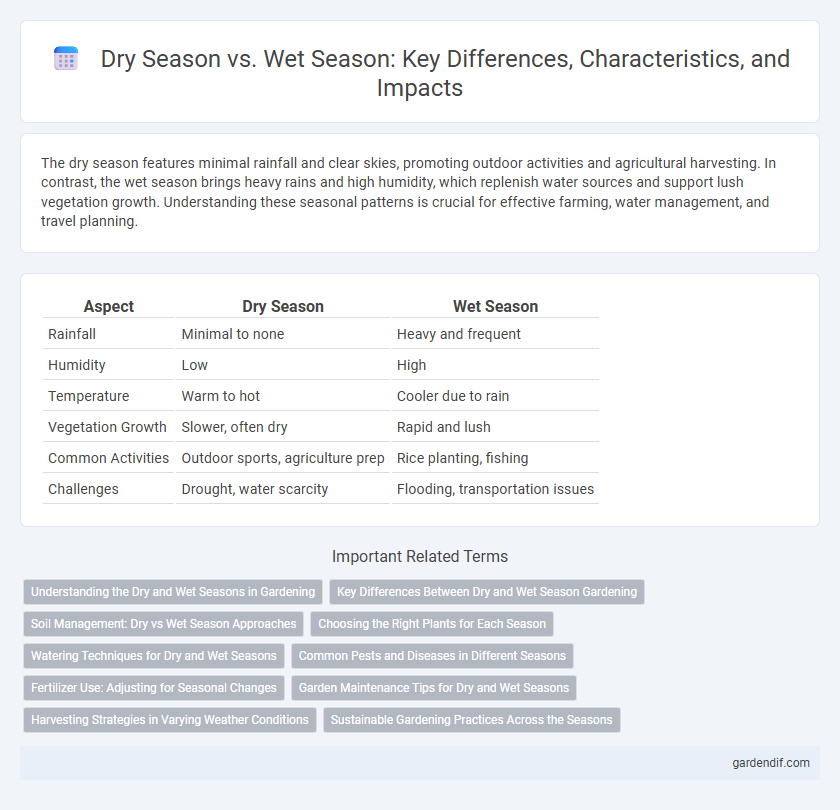
Dry season vs Wet season Illustration
The dry season features minimal rainfall and clear skies, promoting outdoor activities and agricultural harvesting. In contrast, the wet season brings heavy rains and high humidity, which replenish water sources and support lush vegetation growth. Understanding these seasonal patterns is crucial for effective farming, water management, and travel planning.
Table of Comparison
| Aspect | Dry Season | Wet Season |
|---|---|---|
| Rainfall | Minimal to none | Heavy and frequent |
| Humidity | Low | High |
| Temperature | Warm to hot | Cooler due to rain |
| Vegetation Growth | Slower, often dry | Rapid and lush |
| Common Activities | Outdoor sports, agriculture prep | Rice planting, fishing |
| Challenges | Drought, water scarcity | Flooding, transportation issues |
Understanding the Dry and Wet Seasons in Gardening
The dry season features minimal rainfall and lower humidity, requiring gardeners to prioritize efficient irrigation and drought-resistant plant species to maintain healthy growth. In contrast, the wet season brings abundant precipitation and higher moisture levels, promoting rapid plant development but increasing the risk of fungal diseases and soil erosion. Effective gardening during these seasons involves adjusting watering schedules, selecting appropriate plants, and implementing soil drainage solutions to optimize plant health and yield.
Key Differences Between Dry and Wet Season Gardening
Dry season gardening requires drought-tolerant plants and efficient water management techniques due to limited rainfall, while wet season gardening benefits from abundant moisture but demands proper drainage to prevent root rot. Soil preparation differs significantly; rich, well-aerated soil supports plant growth in wet seasons, whereas in dry seasons, mulching helps retain soil moisture and reduce evaporation. Pest and disease control also varies, with wet seasons fostering fungal and insect outbreaks, necessitating vigilant monitoring and organic treatments.
Soil Management: Dry vs Wet Season Approaches
Soil management during the dry season emphasizes moisture conservation techniques such as mulching, minimal tillage, and incorporating organic matter to enhance water retention. In contrast, the wet season requires effective drainage systems, soil erosion control measures, and nutrient management to prevent nutrient leaching and soil compaction. Tailoring soil practices to seasonal conditions optimizes crop productivity and soil health throughout the year.
Choosing the Right Plants for Each Season
Plants adapted to the dry season often have deep root systems and drought-resistant features like thick leaves or waxy coatings to minimize water loss. During the wet season, selecting plants that thrive in high moisture and can tolerate occasional flooding, such as water-loving grasses or tropical varieties, ensures healthy growth. Understanding these seasonal moisture patterns helps gardeners optimize plant survival and maximize garden productivity throughout the year.
Watering Techniques for Dry and Wet Seasons
Watering techniques differ significantly between dry and wet seasons to optimize plant health and conserve water. During the dry season, deep watering early in the morning reduces evaporation and encourages strong root growth, while employing drip irrigation ensures efficient water use. In contrast, the wet season requires minimal supplemental watering, with attention to soil drainage to prevent waterlogging and root rot.
Common Pests and Diseases in Different Seasons
The dry season often promotes the proliferation of pests such as spider mites and aphids, which thrive in low humidity and warm temperatures, leading to increased plant stress and vulnerability. In contrast, the wet season encourages fungal diseases like powdery mildew and root rot due to high moisture levels, creating ideal conditions for pathogen growth. Understanding the seasonal patterns of pests and diseases enables more effective pest management and disease prevention strategies in agriculture and gardening.
Fertilizer Use: Adjusting for Seasonal Changes
Fertilizer application rates must be adjusted according to dry and wet season conditions to optimize nutrient uptake and prevent runoff. During the dry season, slower plant growth reduces nutrient demand, allowing for lower fertilizer amounts and deeper soil incorporation to minimize volatilization. In contrast, the wet season requires split fertilization and use of slow-release formulations to maintain nutrient availability despite heavy rainfall and leaching risks.
Garden Maintenance Tips for Dry and Wet Seasons
During the dry season, focus on deep watering early in the morning to reduce evaporation and use mulch to retain soil moisture. In the wet season, ensure proper drainage to prevent waterlogging and remove fallen leaves regularly to avoid fungal diseases. Adjust pruning schedules according to the growth rate influenced by moisture levels in each season.
Harvesting Strategies in Varying Weather Conditions
Harvesting strategies must adapt to the distinct challenges presented by dry and wet seasons to optimize crop yield and quality. During the dry season, early morning harvesting minimizes heat stress on crops, while the wet season demands efficient drainage and moisture-resistant storage to prevent spoilage. Employing weather-responsive scheduling and equipment ensures maximum productivity across varying seasonal conditions.
Sustainable Gardening Practices Across the Seasons
Sustainable gardening practices adapt to the dry season by emphasizing water conservation techniques such as drip irrigation and mulching to retain soil moisture, while the wet season encourages composting and the use of cover crops to enhance soil fertility and prevent erosion. Seasonal planting schedules aligned with rainfall patterns reduce water waste and support healthy plant growth throughout the year. Utilizing native plants that thrive in local dry and wet conditions further promotes resilience and sustainability in home gardens.
Dry season vs Wet season Infographic

 gardendif.com
gardendif.com